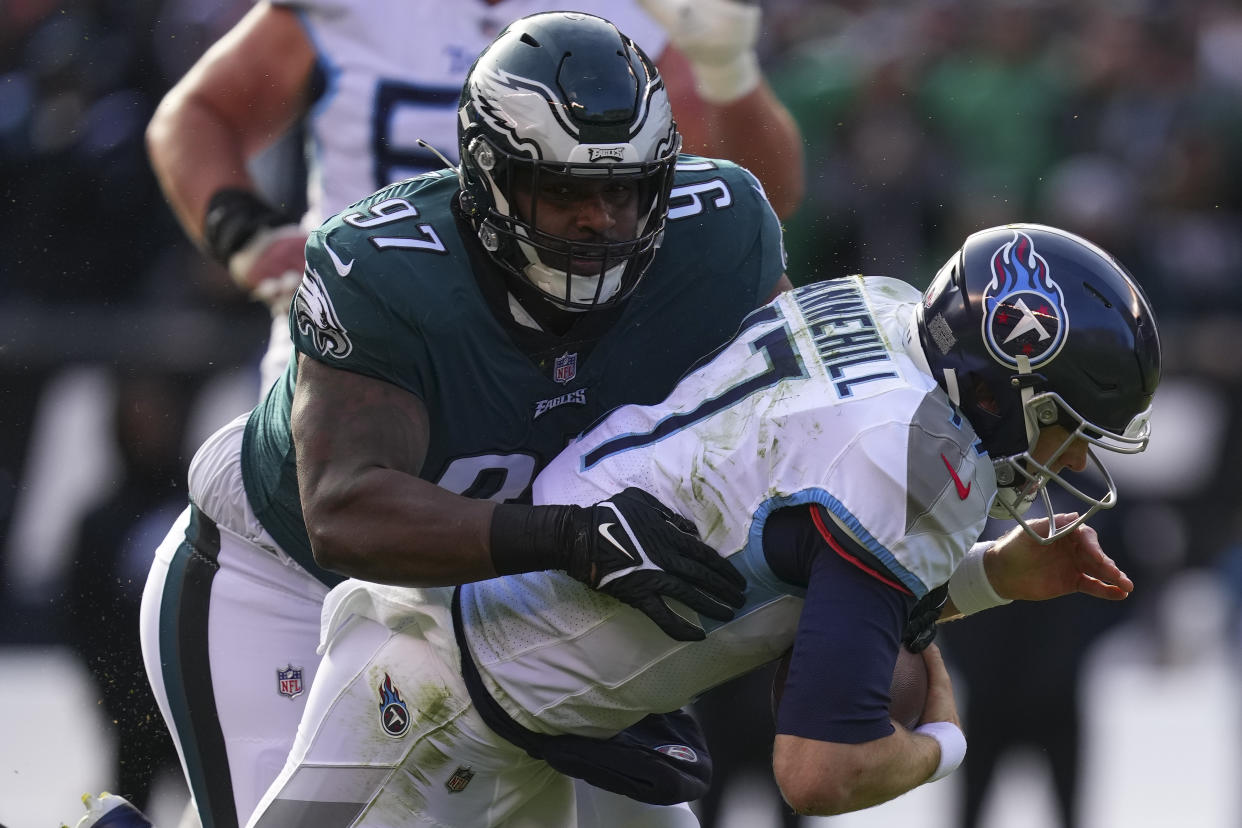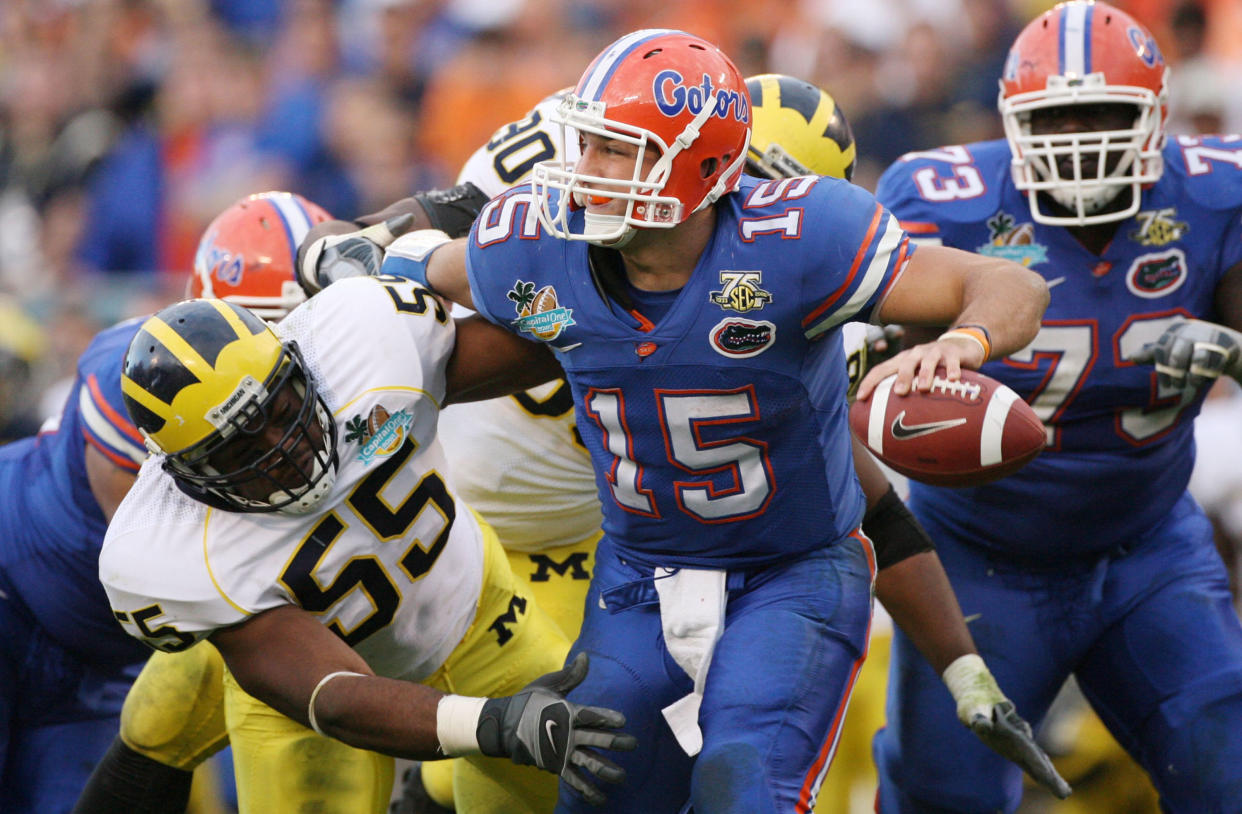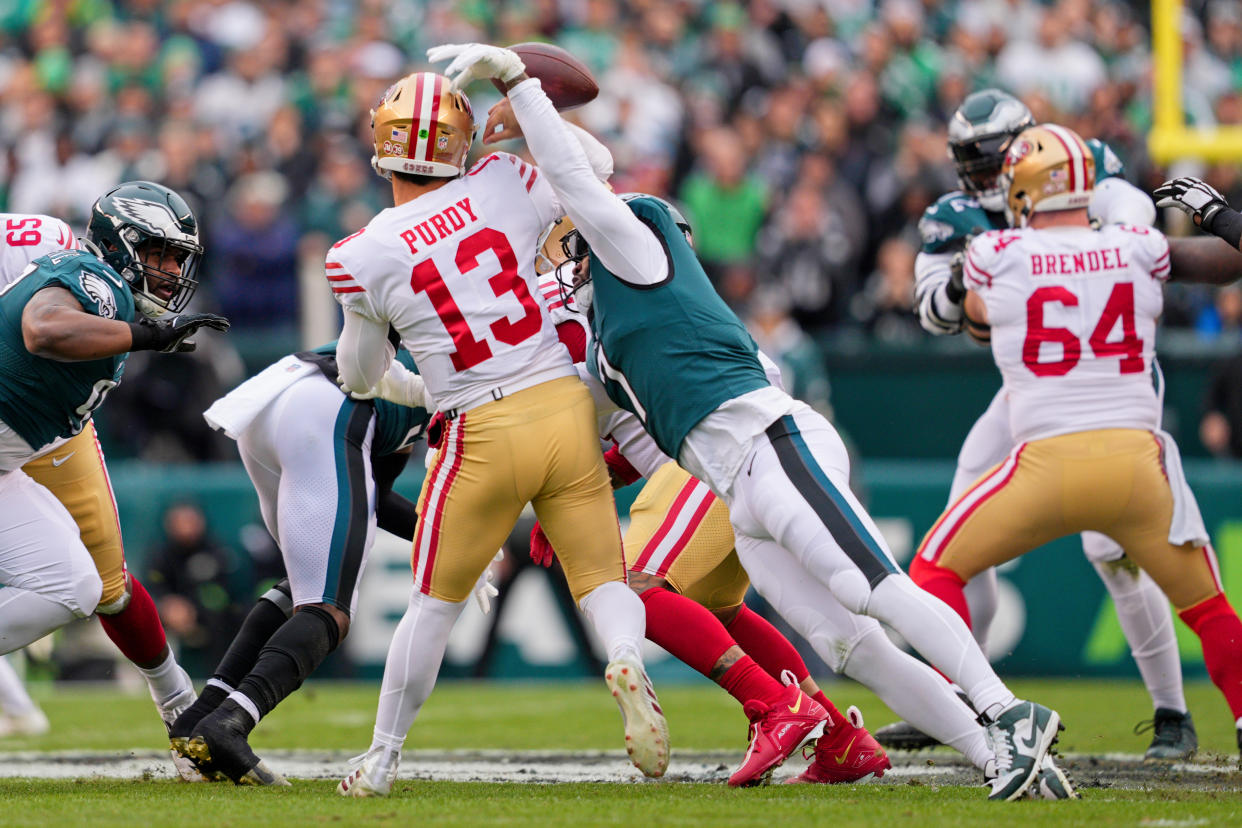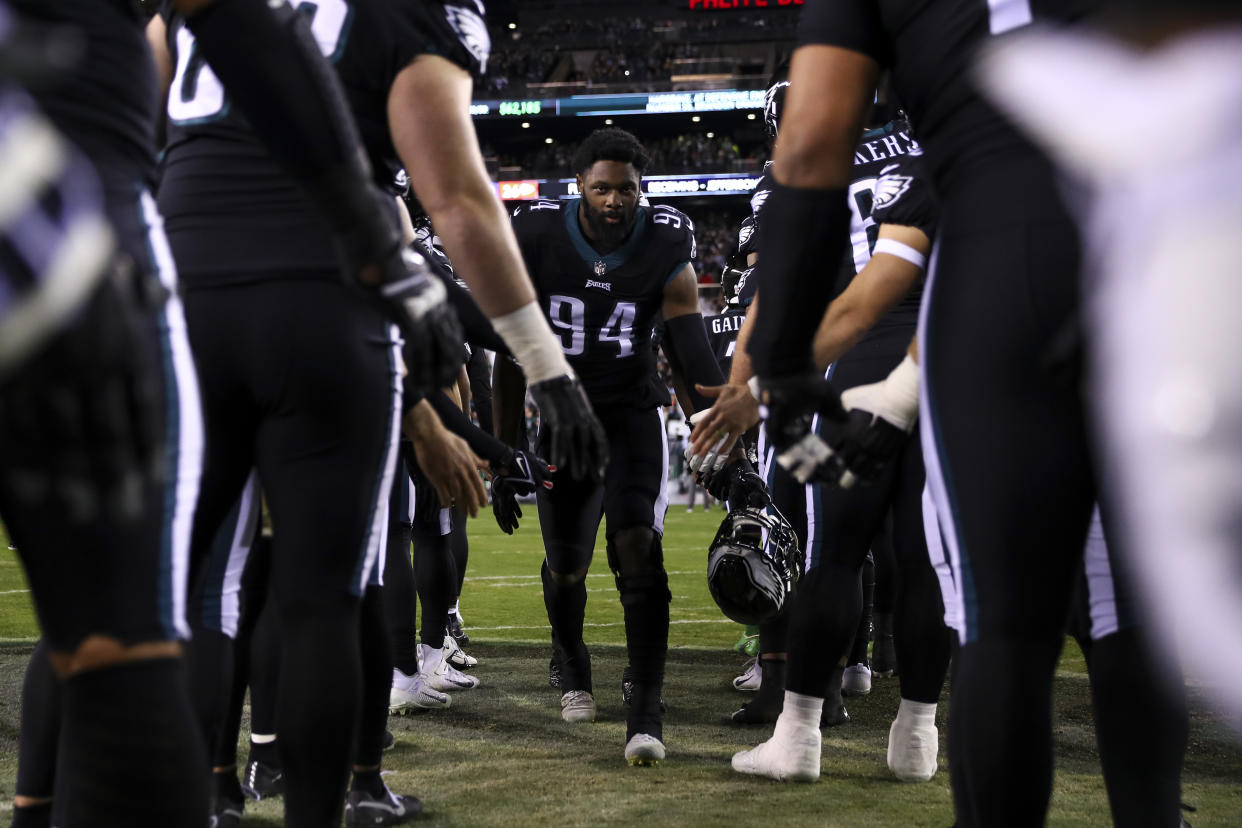Super Bowl LVII: The improbable rise of the Philadelphia Eagles pass rush
One assumed his football dream was dead after he was cut by his college team as a freshman walk-on.
Another floundered academically in high school and watched every college that recruited him give up.
A third hurt his knee so badly that doctors warned him they might have to amputate his lower leg.
A fourth had to make a name for himself playing for a high school that consisted of portable trailers and little else.
Haason Reddick, Javon Hargrave, Josh Sweat and Brandon Graham each took unconventional, obstacle-laden roads to get to the NFL. Now that foursome has come together to spearhead the league’s most menacing pass rush, one that has carried the Philadelphia Eagles all the way to Sunday's Super Bowl.
Relying on a deep rotation of defensive linemen to make quarterbacks uncomfortable, Philadelphia racked up a league-high 70 sacks during the regular season. Reddick, Hargrave, Sweat and Graham combined to produce 49 of those, surpassing the season-long sack totals of 28 other NFL teams.
In the playoffs, the Eagles have only ramped up the pressure, sacking Daniel Jones five times in the divisional round before abruptly waylaying Brock Purdy’s magical ascent in the first quarter of the NFC championship game. Now comes the ultimate test: Patrick Mahomes on the sport’s biggest stage.
It’s a potential moment of triumph for four guys who weren’t supposed to be here.

Javon Hargrave: The zero-star recruit
The most overlooked pass-rushing prospect in the state of North Carolina refused to come out of his bedroom.
Javon Hargrave was ashamed to show his face around his hometown at a time when many of his friends were leaving to play college football and he had nowhere to go.
Hargrave tortured quarterbacks during a record-setting high school career, but that didn’t translate to scholarship offers. Some college programs didn’t know about Hargrave because he played for a struggling lower-division team or shied away from him because he was a few inches shorter than a prototypical defensive tackle.
Hargrave still “could have picked between plenty of colleges,” his former high school coach said, except he wasn’t able to meet the NCAA’s minimum academic requirements. College coaches who watched video of Hargrave bulldozing offensive linemen would stop by North Rowan High School eager to recruit him. “Then you’d pull a transcript,” former North Rowan coach Tasker Fleming said, “and they’d get kind of quiet.”
While Hargrave was a motivated student who attended tutoring sessions and test-prep classes, exams were his undoing. Not only did he struggle to read as quickly as his peers, but he also often experienced debilitating test anxiety. The night before one of his final cracks at the ACT, Hargrave told his dad he had misplaced his ID card. Timothy Bates said with a chuckle, “I didn’t realize until later that he’d mysteriously lost it because he didn’t want to take this test.”
Earning a qualifying ACT score was a months-long struggle for Hargrave, as was improving his core-course GPA enough to meet the NCAA’s threshold. Eventually, even the colleges that wanted Hargrave moved on because they couldn’t get him into school.
“He’ll tell you that was one of the darkest periods of his life,” Bates told Yahoo Sports. “He shut down and stayed in his room to the point where I said, ‘You’ve got to get out of here and do something.’ He gained weight and lost a lot of personality. He couldn’t believe this is where he was in his life.”
Hargrave might be working a 9-to-5 job nowadays were it not for a football scout and regional recruiting writer who didn’t want to see his pass-rushing talent go to waste. Jason Pughe sent Hargrave’s high school highlight video to a friend who coached at South Carolina State and urged him to take a look.
Former South Carolina State running backs coach Lee Chambers watched a handful of clips of Hargrave exploding out of his stance, knifing into the backfield and wreaking havoc. Then he called Pughe back and said, “This kid’s unreal. I’ll be in the car tomorrow morning.”
South Carolina State coaches helped Hargrave enroll in NCAA-approved online courses and make up the credits he was missing. He achieved eligibility and enrolled at the start of the spring semester, though he wasn’t exactly in football shape after months of inactivity and over-eating.
Gasping for air with muscles cramping, Hargrave didn’t make it through his first conditioning session and required a golf cart to return him to his dorm room. It was a discouraging enough start that Chambers actually apologized to defensive coordinator David Blanchard.
“Are you kidding me?” Blanchard responded. “Watch his first step. This kid has something nobody else does. He just isn’t in shape, but this kid is going to be just fine.”
Of course, Blanchard was right. Once Hargrave learned to use his hands to complement his lightning-fast first step, he began to earn his “Grave Digger” nickname. He vaulted himself onto the NFL’s radar as a junior with a six-sack game against Bethune-Cookman. Then he cemented himself as a future draft pick by outperforming highly regarded major-conference defensive tackles at the Senior Bowl and East-West Shrine Game.
Evolving from zero-star recruit to third-round draft pick to NFL standout is remarkable in itself, but maybe the most noteworthy part of Hargrave’s story is what he achieved in the classroom at South Carolina State. The communications major earned mostly A’s and B’s and even made the dean’s list his final two semesters.
“When he got to college, let me tell you something: He was locked in academically,” Blanchard said. “We never had one issue.”

Brandon Graham: A field full of dirt
In August 1992, about a mile north of downtown, the city of Detroit unveiled a new vocational high school consisting of little more than a series of portable trailers.
In the mornings, students attended traditional classes. In the afternoons, they received training at a career center across the parking lot.
Crockett Technical High School had no gym or athletic fields. Its football team practiced at a nearby park on grass that usually turned to dirt by the time the season began. Coaches would chalk the sidelines and yard lines by hand. If practice extended past sundown, everyone had to pull up their cars and turn on the headlights.
“Some of the best players in the state of Michigan came through that school,” former Crockett coach Rod Oden told Yahoo Sports.
That includes a decorated linebacker who went on to become an All-American at Michigan, a first-round draft pick and a Super Bowl hero with the Eagles.
Brandon Graham was already considered one of the top incoming freshmen in Detroit in 2002 when he followed some former youth league teammates to Crockett. Oden said Graham’s parents liked the small-school environment at Crockett and the fact that their son had a chance to play varsity football right away.
From the start, Graham embraced Crockett’s underdog mentality. He didn’t complain about doing pushups, sit-ups and burpees in a hallway instead of a weight room or about changing for practice in a middle school basement instead of a locker room.
Since Crockett typically had around 30 players on its roster, its best players seldom came off the field. Graham played middle linebacker and offensive line while serving as the team’s top kicker and punter. While his combination of 4.5 speed and imposing size was best deployed chasing down ball carriers, it also made Graham a weapon with the ball in his hands. Oden says he scored eight touchdowns at Crockett on fake punts.
“He had the autonomy to fake at any time,” Oden said. “Once he got on the edge, nobody was trying to tackle him.”
Graham helped lead Crockett to the state semifinals as a junior and the district title game as a senior. Along the way, he emerged as one of the nation’s most coveted linebacker recruits and a leader who put the interests of the team above his own.
Each year, the Crockett coaches made their players earn the “C” they wore on their helmets by achieving certain benchmarks. As a senior, Graham told the coaches that neither he nor anyone else would wear the “C” until every player on the team had earned the emblem.
“Half the season, they just wore plain, beat-up practice helmets,” Oden said. “That just made guys bust their butts and work harder.”
Crockett relocated to an old middle school building by the start of Graham’s senior year and closed altogether in 2012. Its blue-collar spirit lives on through Graham, who overcame early injuries and scheme changes with the Eagles to shed the bust label and set himself apart with his relentless motor.
The bonds Graham made at Crockett are lasting, even if the school is now defunct. In the wake of the Eagles’ NFC championship game victory over San Francisco, Graham texted Oden to ask for his date of birth and those of his family members. That was how Oden learned that Graham planned to fly him and his family to Arizona for the Super Bowl.
“He’s such an awesome person,” Oden said. “I never have to ask him for anything. He just always comes through.”

Haason Reddick: The walk-on
In early 2012, a Temple grad assistant approached head football coach Steve Addazio about an intriguing potential walk-on.
A high school senior from Francis Brown’s working-class neighborhood in Camden, New Jersey, had already been admitted to Temple and had the physical tools to play major college football.
Haason Reddick was on pace to start at running back and safety for Haddon Heights High School before he fractured his femur days before the opening game of his junior season. Reddick rehabbed intensely to make it back in time for the start of his senior season, only to tear his meniscus in his second game and undergo surgery once again.
Those injuries left Reddick with no tape to show college coaches, no tangible evidence that he was worthy of a scholarship offer. The torn meniscus might've been the end of his football career, except that Brown was a family friend who had trained Reddick prior to his injuries and believed in his talent.
“I knew how athletic he was,” Brown, now an assistant coach at Georgia, told Yahoo Sports. “I knew that he could run. I knew that he could catch. I knew he was one of the tougher kids I’d known. I knew his family. He wanted to go to college and get his degree. I had an opportunity to help.”
Brown’s recommendation earned Reddick an invitation to join the Temple football team, but his path from preferred walk-on to NFL prospect was anything but smooth. Addazio and his staff, Brown said, “didn’t value who [Reddick] was and what he could do.” In fact, Reddick didn’t make it through his entire freshman season on the scout team before Addazio booted him out of the program over what Brown characterizes as a “misunderstanding.”
Reddick explored pursuing boxing and rap during his hiatus from football, but he stayed in shape just in case he got another chance. When Addazio bolted for Boston College after the 2012 season and Temple hired Matt Rhule to replace him, Brown once again went to bat for his fellow Camden native.
Rhule saw more potential in Reddick than Addazio appeared to, but figuring out where to deploy him proved difficult. For two years, Reddick played on special teams and served as a reserve safety, linebacker and defensive end, filling in wherever he was needed from week to week.
“He could do anything, so it was like, what the heck is he?” Brown recalled. “Anytime we needed something, he could do it, and that kind of hurt him. He ended up always moving around to help instead of being where he needed to be to help himself.”
Winning a training camp battle for Temple’s starting defensive end job as a redshirt junior finally unlocked Reddick’s potential. That position turned Reddick into a lethal attacker. As Brown put it, “it allowed him to play freely without having to think all the time.”
Reddick finally earned a scholarship after his redshirt junior season, a huge relief for a family that had been taking out loans and working extra hours to put him through college. Then, in his final season at Temple, Reddick led the Owls to a conference title and emerged as a surefire first-round draft pick, recording 9.5 sacks and a nation-best 21 tackles for a loss.
Selected 13th overall by the Arizona Cardinals in 2017, Reddick struggled to make an early impact. The Cardinals moved him inside for his first three seasons before he persuaded Kliff Kingsbury to move him back to the edge in 2020.
That spot is clearly where Reddick belongs. He had double-digit sacks each of the past three seasons, including a career-best 16 this season for his childhood-favorite Eagles.
In the NFC championship game against San Francisco, it was Reddick who was the most unblockable player on the field. He tallied two sacks, including the key one that knocked Purdy out of the game and propelled the Eagles to the Super Bowl.
“Blessings on blessings on blessings,” Reddick told reporters after the game. “I didn’t see this coming, and now that it’s here, I’m at a loss for words.”

Josh Sweat: The devastating injury
The freak injury that nearly ended Josh Sweat’s football career is seared into his high school coach’s memory.
Richard Morgan remembers every haunting detail: the violent collision, the dangling leg and the sickening silence.
In September 2014, Sweat was among the nation’s most ballyhooed football prospects, a 6-foot-5, 240-pound force of nature who was as comfortable terrorizing quarterbacks as he was making acrobatic, one-handed catches. The Chesapeake, Virginia, native seldom took any plays off, not even an extra point in the second quarter of an early season game that his team already led 28-6.
As Sweat rushed around the left edge unblocked, he jumped with his arms outstretched to try to block the kick. Sweat’s plant foot came down and caught in the grass at the same time that a teammate rushing from the other side made a diving attempt to block the extra point and careened into his knee.
The collision bent Sweat’s left leg in a way it shouldn’t bend, dislocating his kneecap and tearing three major knee ligaments. Immediately, it was obvious to Morgan that Sweat’s senior season was over. He just hoped Sweat wouldn’t be sidelined longer than that.
“I’ve been coaching for 30 years, and that’s right up there with the worst moments of my career,” Morgan told Yahoo Sports. “You feel so bad for the young man because you know how good a player he is and how hard he has worked.”
After an ambulance rushed Sweat to a nearby hospital, medical personnel assessed his mangled leg. They warned that there was a chance they would have to amputate the bottom of his leg if tests revealed sufficient artery damage.
The next few hours were excruciating for Sweat and his family. No longer did he seem certain to become the next Jadaveon Clowney, to have his pick of big-time colleges and someday play in the NFL. Suddenly, there was a chance he’d require a prosthetic leg and a totally new career path.
Thankfully for Sweat, he avoided that worst-case scenario. Further tests revealed no nerve or artery damage. The strength and power that made Sweat an elite football player also shielded him from a more severe injury.
“Once I heard that, I started to feel a little better,” Morgan said. “It was like, ‘OK, he can come back from this.’”
Even though Sweat underwent surgery and was confined to a wheelchair for a couple of months, the college programs that were pursuing him did not abandon him. Sweat ultimately chose Florida State over the likes of Virginia Tech, Georgia, Oregon and Ohio State after Jimbo Fisher assured Sweat’s family that he would have the chance to earn playing time as a true freshman.
Less than a year after doctors feared he wouldn’t play football again, Sweat made his college debut in Florida State’s opener against Texas State, posting three tackles. He went on to post three solid seasons for the Seminoles and led the team with 5.5 sacks as a junior, but he never did live up to the next Clowney hype.
Since the Eagles drafted him in the fourth round in 2018 and helped him harness his speed and quickness to attack the quarterback, Sweat has performed more and more like the impact player he was projected to be in high school. In 2021, he signed a three-year, $40 million contract extension and made the Pro Bowl. This season, he posted a career-best 11 sacks and had a 42-yard pick 6 off Dak Prescott.
“If someone was going to come back from an injury like this, it was going to be him,” Morgan said. “He was going to find a way to conquer any obstacle. He was not going to be denied.”
